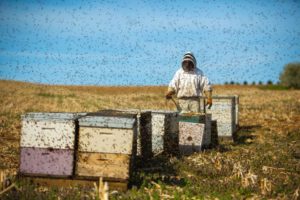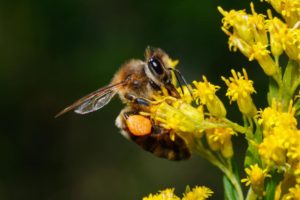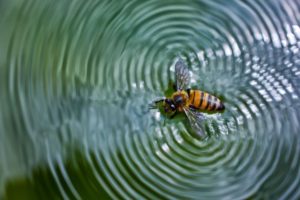 Honey Bees
Honey Bees
Bees are one of the reasons we have food and the only reason we have honey! Check out what the American Beekeeping Federation has to say about the Honey Bee.
- “Approximately one third of all the food Americans eat is directly or indirectly derived
 from honey bee pollination. Some crops pollinated are cucumbers, almonds, carrot seed, melons, apricots, cherries, pears, apples, prunes, plums, pluots, seed alfalfa, cantaloupe, seed onions, avocados, kiwi, blueberries, cranberries, etc.
from honey bee pollination. Some crops pollinated are cucumbers, almonds, carrot seed, melons, apricots, cherries, pears, apples, prunes, plums, pluots, seed alfalfa, cantaloupe, seed onions, avocados, kiwi, blueberries, cranberries, etc. - There are three members of a honey bee colony:
Queen – mother to all the bees in the colony; she is a fertile female.
Worker – an infertile female that performs the labor tasks of the colony, including feed preparation, guarding the hive, feeding the queens, drones and brood, and heating and cooling the hives.
Dron e – the male that starts out as an unfertilized egg. Its only purpose in the colony is to mate with a virgin queen. They live to mate with the queen, but not more than one in a thousand get the opportunity to mate.
e – the male that starts out as an unfertilized egg. Its only purpose in the colony is to mate with a virgin queen. They live to mate with the queen, but not more than one in a thousand get the opportunity to mate.
- On average, a worker bee in the summer lasts six to eight weeks. Their most common cause of death is wearing their wings out. During that six to eight-week period, their average honey production is 1/12 of a teaspoon. In that short lifetime, they fly the equivalent of 1 1/2 times the circumference of the earth.
- The peak population of a colony of honeybees is usually at mid-summer (after spring buildup) and results in 60,000 to 80,000 bees per colony. A good, prolific queen can lay up to 3,000 eggs per day.” (2015)Find more benefits here: https://authoritynutrition.com/10-benefits-of-honey/
Learn More (Videos):
How honey is made: https://www.youtube.com/watch?v=iT6IQx26eHk
Beehive equipment: https://www.youtube.com/watch?v=WWLsaPjGws4
New beehive innovation from Australia: https://www.honeyflow.com/gallery-videos/meet-the-beekeeper-videos/p/225
Learn More (Fun Facts):
http://www.utahcountybeekeepers.org/fun_facts.html
Learn More (Photos):
http://animals.nationalgeographic.com/animals/bugs/honeybee/
Images courtesy of: http://news.nationalgeographic.com/2015/08/150815-honeybee-honey-pollination-science/#/01honeybeegallery.jpg; http://news.nationalgeographic.com/2015/08/150815-honeybee-honey-pollination-science/#/05honeybeegallery.jpg, http://news.nationalgeographic.com/2015/08/150815-honeybee-honey-pollination-science/#/06honeybeegallery.jpg; http://news.nationalgeographic.com/2015/08/150815-honeybee-honey-pollination-science/#/07honeybeegallery.jpg


